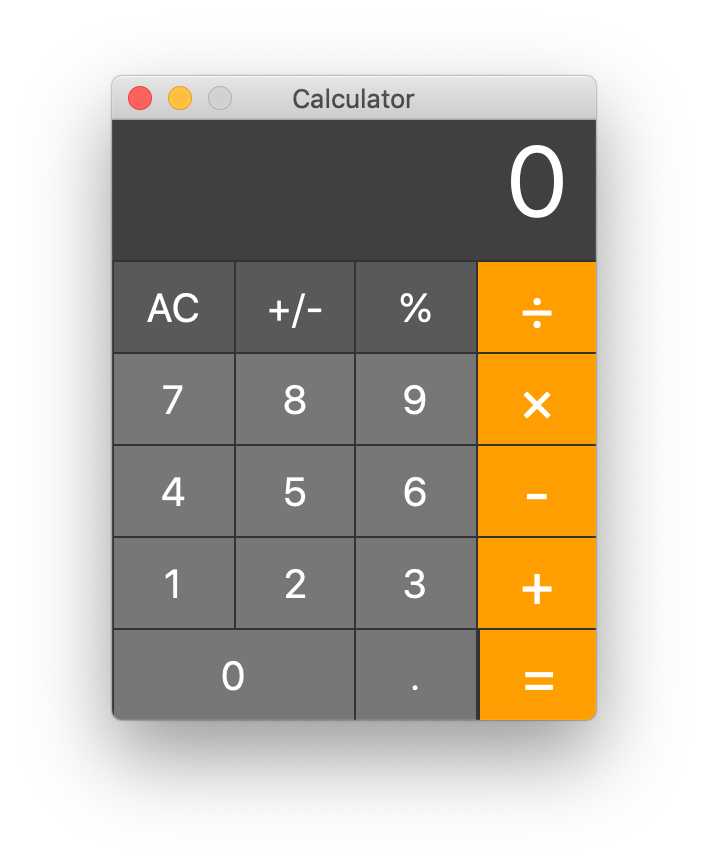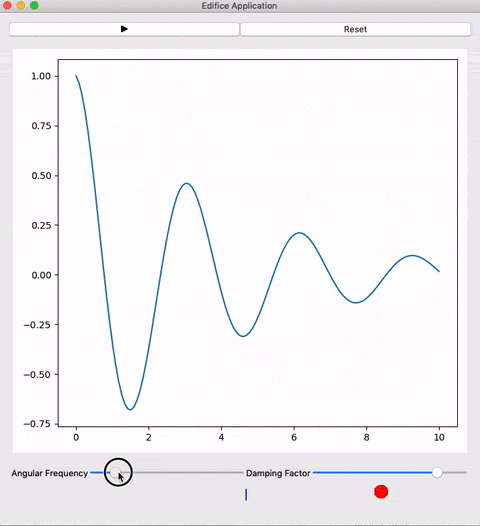Edifice: A Declarative UI Library¶
“Make simple UI easy and complex ones straightforward.”


Installation for version 0.0.8:
pip install pyedifice
import edifice
from edifice import Label
edifice.App(Label("Hello World!")).start()
Edifice is a Python library for building reactive UI, inspired by modern Javascript libraries such as React. Edifice makes it simple to build a fully reactive UI without ever leaving Python, getting the best of both worlds:
Modern paradigms from web development that simplify UI creation
Fast iteration via hot reloading
Seamless integration with the Python ecosystem (standard library, numpy, matplotlib, pandas, etc)
A native desktop app without the overhead of bundling a browser.
Edifice uses Qt as a backend (although it could be generalized to other backends).
Getting Started¶
Edifice is inspired by React JS. If you have experience with React, you will find Edfice very easy to pick up.
The easiest way to get started is via the Tutorial. To understand the core conception behind Edifice, see Edifice Core Concepts.
Here are a few simple examples to get you started:
Simple Forms¶
The Form component in the Edifice library make it really easy to create a simple Form. Data in a dictionary are mapped to form elements according to the data type: strings to TextInput, bools to Checkbox, etc. The example below shows how you can collect information from the user in a Dialog.
import datetime
import edifice
from edifice.components.forms import FormDialog
# StateManagers are key-value stores that UI components can bind to reactively:
# a change in the StateManager will refresh all subscribed UI components
fields = edifice.StateManager({
"Name": "", # text input
"Age": 20, # text input with validation
"Date": datetime.date(2021, 2, 1), # 3 dropdowns
"Country": ("USA", ["USA", "UK", "France", "Japan"]), # dropdown
"agreed": True, # checkbox
})
edifice.App(FormDialog(fields)).start()
print(fields["Name"])
A Stateful Component¶
A component can maintain internal state, stored as attributes of the component.
When this state is changed using the set_state method,
the component will be re-rendered using the provided render function.
import edifice
class Timer(edifice.Component):
def __init__(self):
super().__init__()
self.seconds = 0
self.timer = edifice.Timer(lambda: self.set_state(seconds=self.seconds+1))
def did_mount(self):
self.timer.start(1000)
def render(self):
return edifice.Label(self.seconds, style={"width": 80, "height": 30, "font-size": 20})
edifice.App(Timer()).start()
An Application¶
Components can be composed to create composite components. By making components modular, you can reuse them in your application and across applications.
import datetime
import edifice
from edifice import Button, Label, TextInput, ScrollView, View
class TodoApp(edifice.Component):
def __init__(self):
super().__init__()
self.items = []
self.text = ""
def render(self):
return View(style={"margin": 10})(
Label("TODO"),
TodoList(items=self.items),
View(layout="row")(
Label("What needs to be done?"),
TextInput(self.text,
on_change=lambda text:self.set_state(text=text)),
Button(f"Add #{len(self.items)+1}",
on_click=self.add_item)
)
)
def add_item(self, e):
if not self.text:
return
new_item = dict(text=self.text, id=datetime.datetime.now())
self.set_state(items=self.items + [new_item])
class TodoList(edifice.Component):
@edifice.register_props
def __init__(self, items):
pass
def render(self):
return ScrollView()(
*[Label(f"* {item['text']}").set_key(item['id'])
for item in self.props.items]
)
edifice.App(TodoApp()).start()
Why Edifice?¶
The premise of Edifice is that GUI designers should only need to worry about what is rendered on the screen, not how the content is rendered. Most existing GUI libraries in Python, such as Tkinter and Qt, operate imperatively. To create a dynamic application using these libraries, you must not only think about what to display to the user given state changes, but also how to issue the commands to achieve the desired effect.
Edifice allows you to describe what should be rendered given the current state, leaving the how to the library. User interactions update the state, and state changes update the GUI. You only need to specify what is to be displayed given the current state and how user interactions modify this state. Edifice will ensure that the displayed widgets always correspond to the internal state. For example, you can write:
View(layout="row")(
Button("Add 5", on_click=lambda:self.set_state(data=self.number + 5)),
Label(self.number)
)
and get the expected result: the GUI always displays a button and a label displaying the current value of self.number. Clicking the button adds 5 to the number, and Edifice will handle updating the GUI.
Edifice is designed to make GUI applications easier for humans to reason about. Thus, the displayed GUI always reflect the internal state, even if an exception occurs part way through rendering — in that case, the state changes are unwound, the display is unchanged, and the exception is re-raised for the application to handle. You can specify a batch of state changes in a transaction, so that either all changes happen or none of them happens. There is no in-between state for you to worry about.
Declarative UIs are also easier for developer tools to work with. Edifice provides two key features to make development easier:
Dynamic reloading of changed source code. This is especially useful for tweaking the looks of your application, allowing you to test if the margin should be 10px or 15px instantly without closing the app, reopening it, and waiting for everything to load.
Component inspector. Similar to the Inspect Elements tool of a browser, the component inspector will show you all Components in your application along with the props and state, allowing you to examine the internal state of your complex component without writing a million print statements. Since the UI is specified as a (pure) function of state, the state you see completely describes your application, and you can even do things like rewinding to a previous state.
QML is another declarative GUI framework for Qt. Edifice differs from QML in these aspects:
Edifice interfaces are created purely in Python, whereas QML is written using a custom markup language.
Because Edifice interfaces are built in Python code, binding Python code to the declared UI is much more straightforward.
Edifice makes it easy to create dynamic applications. It’s easy to create, shuffle, and destroy widgets because the interface is written in Python code. QML assumes a much more static interface.
An analogy is, QML is like HTML + JavaScript, whereas Edifice is like React.js. While QML and HTML are both declarative UI frameworks, they require imperative logic to add dynamism. Edifice and React allow fully dynamic applications to be specified declaratively.
Edifice is still currently under development, and some Qt widgets/functionality are not supported. However, it is easy to interface with Qt, either incorporating a Qt Widget into an Edifice component, use Qt commands directly with an existing Edifice component, or incorporating Edifice components in a Qt application.
Documentation¶
License and Code Availability¶
Edifice is released under the MIT License. The source code is avaliable here.
Support¶
File all bug reports or feature requests using Github issues.